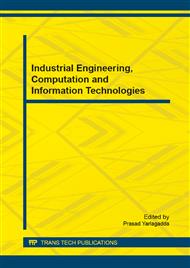[1]
Zhao H, Zhu H. Research of Chinese Word Segmentation Based on Double-Array Trie; Journal of Hunan University(Natural Sciences), 2009 36(5): pp.77-80.
Google Scholar
[2]
Zhao Z, Chen T, Zhu L. A new word segmentation strategy based on phraseology; Journal of Suzhou University (Natural Sceince) , 2002 18(3): pp.44-48.
Google Scholar
[3]
Mo J, Zheng Y, Shou z etc, Improved Chinese word segmentation method based on dictionary. Computer Engineering and Design, 2013 34(5): pp.1802-1807.
Google Scholar
[4]
Xue Nianwen. Labeling Chinese Predicates with Semantic Roles. Computational Linguistics . (2008).
Google Scholar
[5]
Li Jiafu, Segmenting Chinese Based on Probabilistic Model, Journal of System Simulation, 2002 14(5): pp.544-547.
Google Scholar
[6]
Liu Shanfeng etc, Chinese Character Based Segmentation Using Hidden Markov Model, the 12th National Conference on Man-Machine Speech Communication.
Google Scholar
[7]
ZHAO Hai, Chunyu Kit, Effective Subsequence-Based Tagging for Chinese Word Segmentation. Journal of Chinese Information Processing, 2007 21(5): 8-13.
Google Scholar
[8]
Huang Degen, Jiao Shidou, and Zhou Huiwei, Dual-Layer CRFs Based on Subword for Chinese Word Segmentation. Journal of computer research and development 2010 47(5): 962-968.
Google Scholar
[9]
Zhou Jun-sheng; Dai Xin-yu; Ni Rui-yu; Chen Jia-jun, A Hybrid Approach to Chinese Word Segmentation around CRFs, Proceedings of the Fourth SIGHAN Workshop on Chinese Language Processing, Jeju Island, Korea, October 14, (2005).
Google Scholar
[10]
Dong Song and Anoop Sarkar. Voting between Dictionaray-based and Subword Tagging Models for Chinese Word Segmentation [ C]/Proceedings of the Fifth SIGHAN Workshop on Chinese Language Processing. Sydney, Australia, 2006: 126-129.
Google Scholar
[11]
Ruiqiang Zhang, Genichiro Kikui and Eiichiro Sum-ita. Subword-based tagging for confidence-dependent Chinese word segmentation[C]/Proc. of the COLING/ACL on Main conference poster sessions. Sydney, Australia, 2006: 961-968.
DOI: 10.3115/1273073.1273196
Google Scholar
[12]
LUO Yanyan, HUANG Degen, Chinese Word Segmentation Based on the Marginal Probabilities Generated by CRFs , JOURNAL OF CHINESE INFORMATION PROCESSING, 2009 v23(5): 3-8.
Google Scholar
[13]
HUANG Chang-ning, ZHAO Hai, Chinese Word Segmentation: A Decade Review; JOURNAL OF CHINESE INFORMATION PROCESSING; 2007 v21(3): 8-19.
Google Scholar
[14]
andi wu . Chinese word segmentation in msr-nlp[a]. in: proceedings of the second sighan workshop on Chinese language processing [c]. Sapporo, japan : july 11-12, 2003, 172-175.
DOI: 10.3115/1119250.1119277
Google Scholar
[15]
YANG Xiao-jia, JIANG Wei, HAO Wen-ning, Implementation of Field Word SegmentationBased on Ontology and Syntax Analysis, computer engineering, 2008, v34(23): 26-28.
Google Scholar
[16]
LAI Shiwei, XU Lisheng, CHEN Yubo, LIU Kang etc, Chinese Word Segment Based on Character Representation Learning. Journal of Chinese Information Processing, 2013 v27(5) : 8-14.
Google Scholar
[17]
Zheng Xiaogang, Han lixin etc; a Combination-Type Chinese Word Segmentation Method ; Computer Applications and Software 2012 29(7) : 26-29.
Google Scholar


